I have a Sansui 300 receiver from around 1970/71. It has been in storage (in original box) for around 20 years.
I have cleaned it all up and it all works lovely. A few bulbs are gone and the pots need a clean, the main problem I have is noise, like background FM radio hiss noise coming from one channel.
Turning the volume knob doesn't change it, its in all modes (radio, phono etc) mono and stereo.
Bass and treble however seem to have a slight effect on it.
Any ideas? Failing cap? I have the schematic and service manual but wouldn't know where to start.
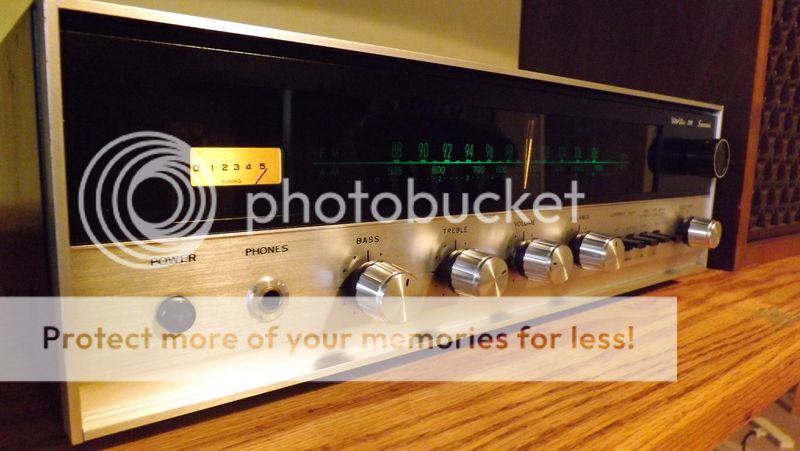
I have cleaned it all up and it all works lovely. A few bulbs are gone and the pots need a clean, the main problem I have is noise, like background FM radio hiss noise coming from one channel.
Turning the volume knob doesn't change it, its in all modes (radio, phono etc) mono and stereo.
Bass and treble however seem to have a slight effect on it.
Any ideas? Failing cap? I have the schematic and service manual but wouldn't know where to start.

Are these the ones?
2SC1845 TRANSISTOR | eBay
Listed as 2SC1845 TRANSISTOR the in the description it states 2SC1845 TRANSISTOR 2SC1845 C1845 KSC1845.
I also found this write up, Improving the Sansui 2000x Receiver Power Amp Section by Conrad Hoffman
Fixing and Modifying the Sansui 2000x Receiver
Mouser also stock these.
http://uk.mouser.com/ProductDetail/Fairchild-Semiconductor/KSC1845FTA/?qs=%2fha2pyFadui1Tr1jWAG49KpTEfbpcq478loV8h3u9wOPZ1nCiKjDz08KaVl7tmDW
Im a bit worried about the pinout matching the original and if not getting it mounted correctly.
2SC1845 TRANSISTOR | eBay
Listed as 2SC1845 TRANSISTOR the in the description it states 2SC1845 TRANSISTOR 2SC1845 C1845 KSC1845.
I also found this write up, Improving the Sansui 2000x Receiver Power Amp Section by Conrad Hoffman
Fixing and Modifying the Sansui 2000x Receiver
The Sansui 2000x is a good sounding and popular vintage receiver. Unfortunately, one of the small signal transistors used in various places has a history of becoming noisy. This is the notorious 2SC458LG. There are various commonly available parts that can replace it, but I can only vouch for parts I've measured and tested. On-line you'll find 2SC1815 or 2SC1815L, 2SC1775 and 2SC2240 suggested. I've checked various parts and found the 2N5088 to be the best. It's closely followed by 2N4401, 2N3904 and MPS-A06, any of which I wouldn't hesitate to use. The common 2N2222 has about twice the noise as does 2N3416. The only caution is that the original part has a pinout of BCE and many common plastic transistors will be EBC. You have to be careful to get the right leads inserted in the right holes during replacement. More on that later.
The 2SC458LG is used in the tone control stages, the power amp stage and there's even one in the multiplex section, for a total of nine devices. I suggest you change all of them except the multiplexer (unless you can do a tuner alignment) as none are very difficult to get to, the parts are inexpensive and the failure rate is high. People tend to be paranoid about capacitors in vintage gear, and less so about semiconductors, but your 2000x is far more likely to have the latter than the former.
Mouser also stock these.
http://uk.mouser.com/ProductDetail/Fairchild-Semiconductor/KSC1845FTA/?qs=%2fha2pyFadui1Tr1jWAG49KpTEfbpcq478loV8h3u9wOPZ1nCiKjDz08KaVl7tmDW
Im a bit worried about the pinout matching the original and if not getting it mounted correctly.
Last edited:
Ksc1845 is a clone of the 2sc1845, exactly the same. I would not order those from Wbay though, as you would be getting fake parts. Get them from Mouser or Digikey instead.
Freeze spray may work, but don't count on it in this case.
Pin out is most likely the same. Do a hFE check with your multimeter to confirm.
The fade out thing is normal on old amplifiers such as this. Not a fault.
Freeze spray may work, but don't count on it in this case.
Pin out is most likely the same. Do a hFE check with your multimeter to confirm.
The fade out thing is normal on old amplifiers such as this. Not a fault.
1970 to 2015 is 45 years, right? That's well beyond an electrolytic capacitor's useful life and that goes for shelf life too. Most caps will only be doing a fraction their intended duty by now and you can expect the problems to show up as you power up more often. Let's hope they are not catastrophic as a 1975 Sansui model a friend recently destroyed did, about a month after taking out of long term storage. The output transistors were not available so it needed a rebuild of both channels with mods to get it it to perform - $$$!
Don't risk this sort of disaster. Replace all the electrolytic caps with similar or even 50% higher capacitance parts and the same or higher voltage rating - never less. New parts will be significantly smaller than the originals and probably much better quality if bought from bona fide electronic parts suppliers - not Ebay fakers.
Don't risk this sort of disaster. Replace all the electrolytic caps with similar or even 50% higher capacitance parts and the same or higher voltage rating - never less. New parts will be significantly smaller than the originals and probably much better quality if bought from bona fide electronic parts suppliers - not Ebay fakers.
Guys, from what I can gather the pinout are the same, can you verify this in case I am reading it wrongly?
2SC458LG (present)
http://pdf1.alldatasheet.com/datashe.../2SC458LG.html
KSC1845FTA (replacement)
http://www.farnell.com/datasheets/1934613.pdf
That's assuming the 2SC458LG are the same as the ones in my amp, the service manual and schematic both state them to be 2SC458LG.
2SC458LG (present)
http://pdf1.alldatasheet.com/datashe.../2SC458LG.html
KSC1845FTA (replacement)
http://www.farnell.com/datasheets/1934613.pdf
That's assuming the 2SC458LG are the same as the ones in my amp, the service manual and schematic both state them to be 2SC458LG.
Perhaps you don't look at technical illustrations too often but surely you don't need others to confirm that the pin sequence shown on either of the 2 datasheets is the same. If in doubt due to a mental blockage or whatever, quickly redraw either from the other's viewpoint for yourself.
That's what I thought Ian, but I have been also told on other threads that they are reversed.
Sansui Solid State 300. - AudioKarma.org Home Audio Stereo Discussion Forums
So I wasn't too sure.
2SC458 (LG) is ECB as is KSC1845.
The boards are marked so it shouldn't be a problem anyway but I thought I would ask just in case I missed something.
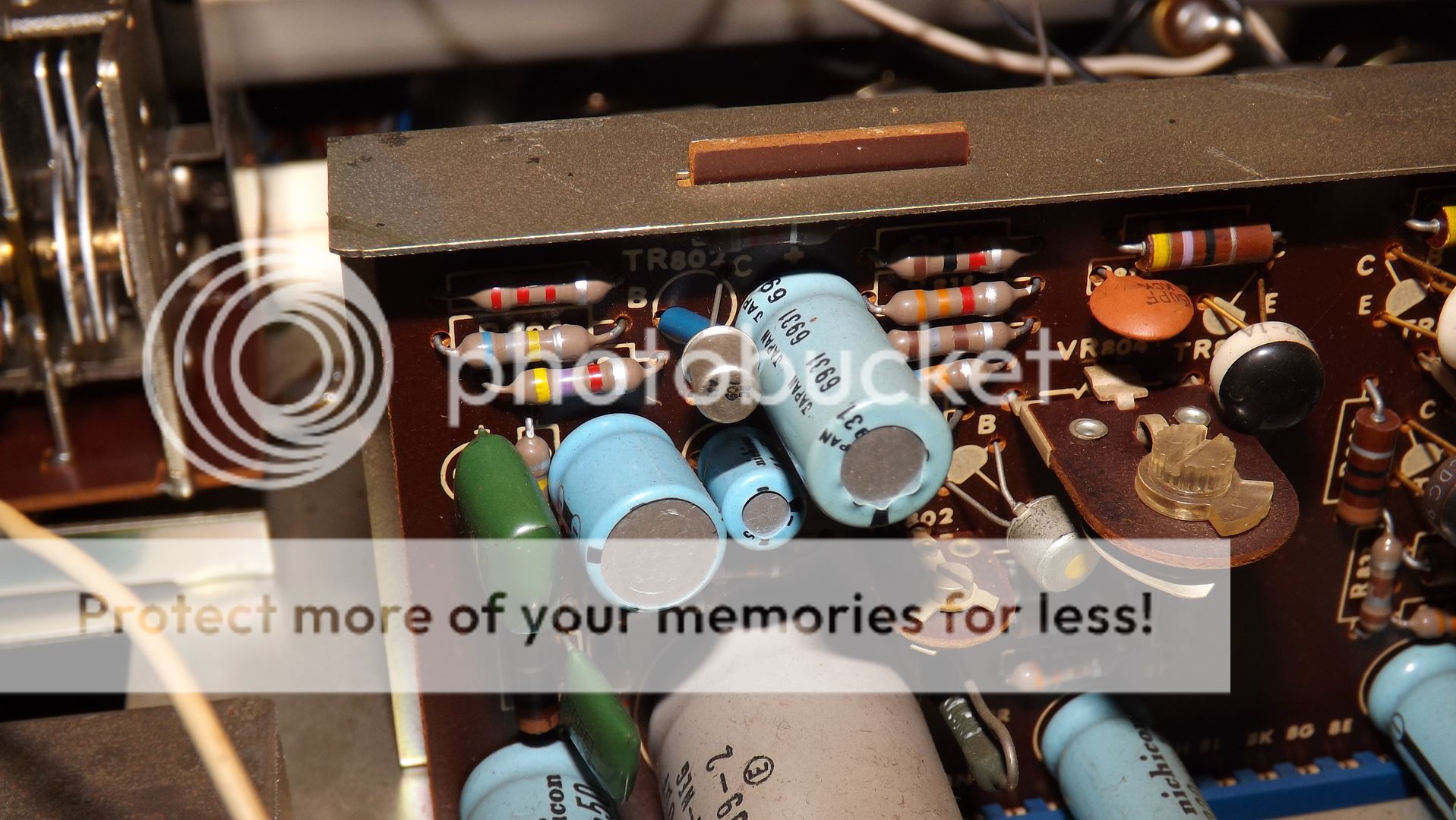
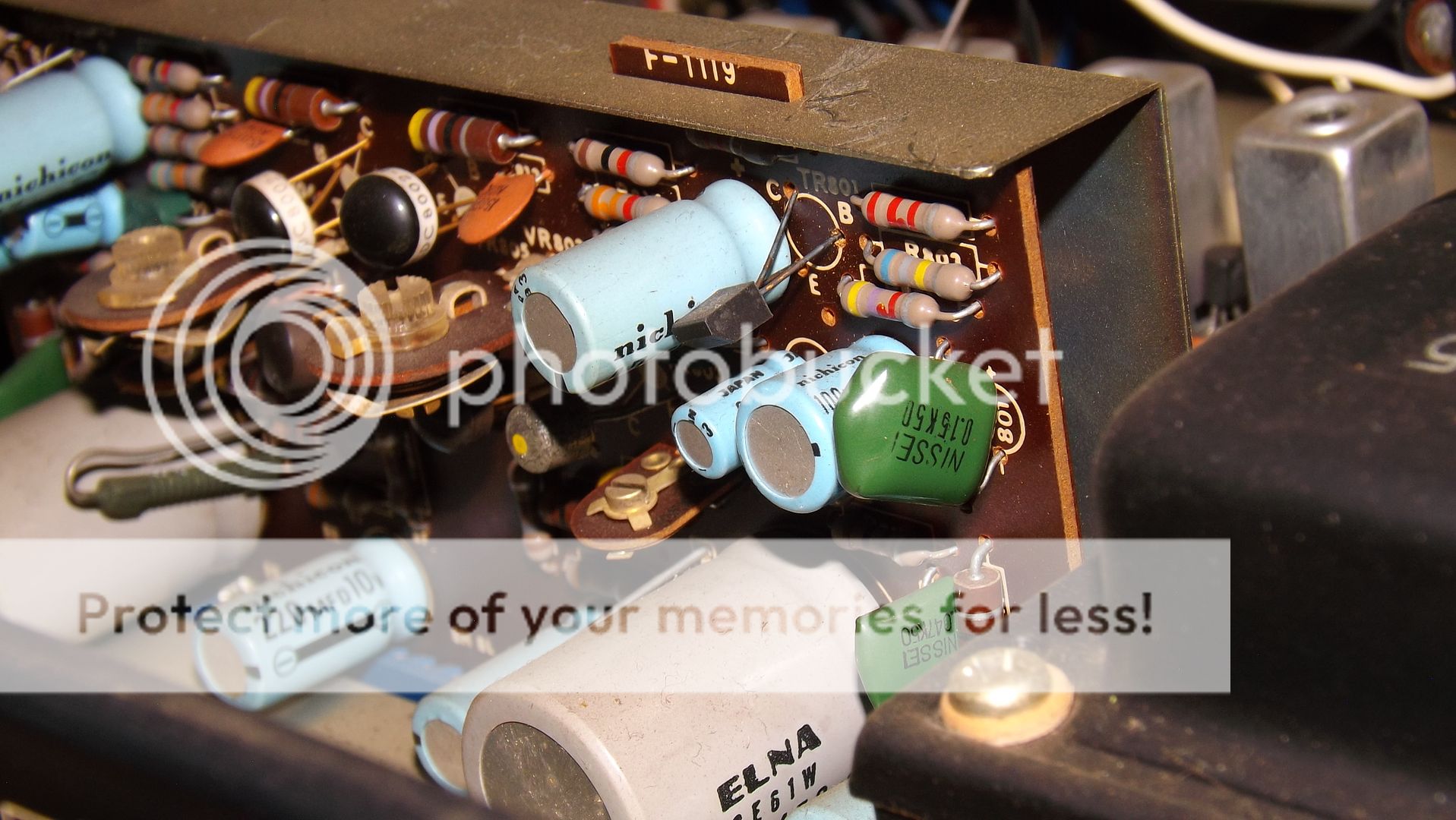
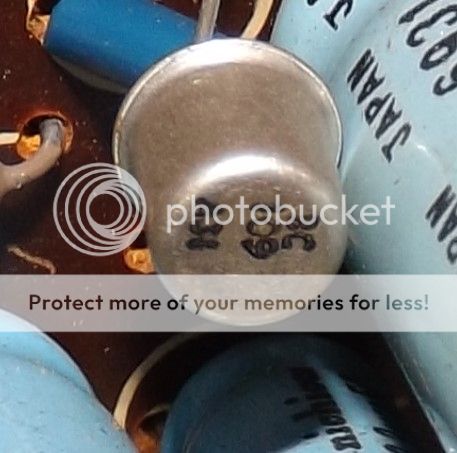
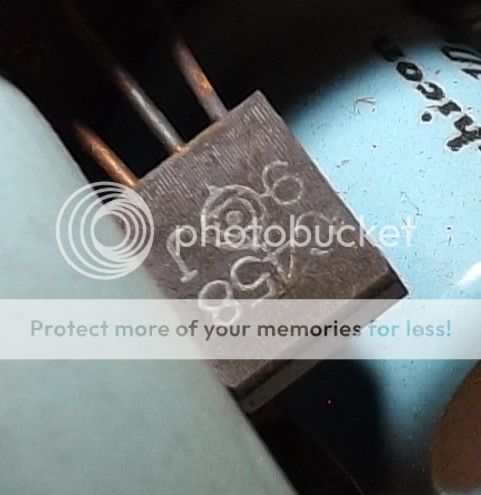
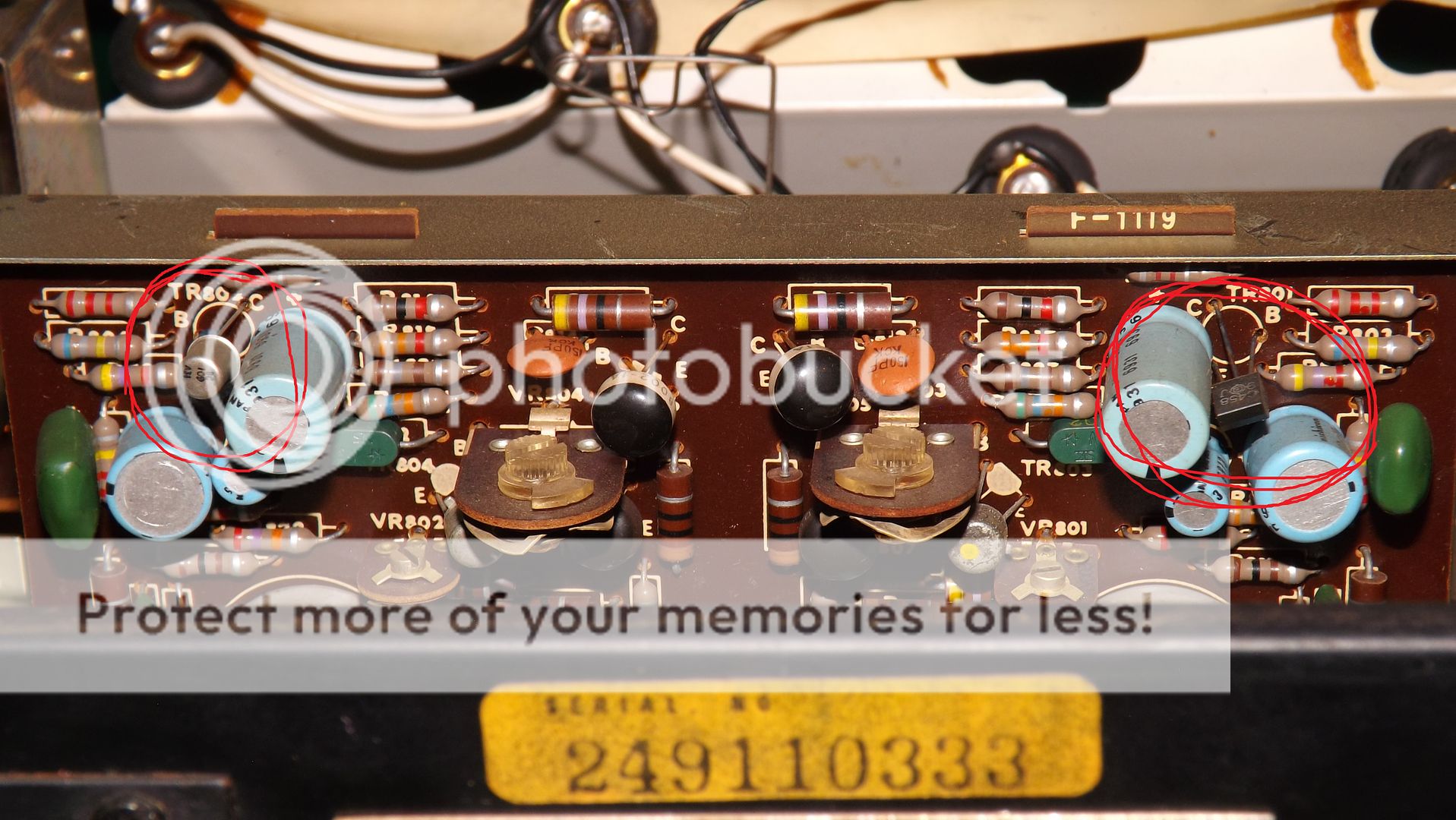


Sansui Solid State 300. - AudioKarma.org Home Audio Stereo Discussion Forums
So I wasn't too sure.
2SC458 (LG) is ECB as is KSC1845.
The boards are marked so it shouldn't be a problem anyway but I thought I would ask just in case I missed something.







Last edited:
Quite confusingly, 2SC458s existed in both ECB and "classic" EBC pinout, same for their replacements. No problem as long as you've got their right ones, anyway. This particular type is quite notorious and should be replaced. And as mentioned, 45-year-old Japanese electrolytics are not to be trusted either.
Should any of the BC109s be bad (they are not badly-reputed but still quite old), there still seems to be some old stock floating around. Otherwise BC549 should be equivalent (or better) save for lower Pdiss.
Should any of the BC109s be bad (they are not badly-reputed but still quite old), there still seems to be some old stock floating around. Otherwise BC549 should be equivalent (or better) save for lower Pdiss.
The schematic doesn't list any BC109's , The transistors listed on the schematic are,
2SK19
SE3001
2SC829
2SC454
2SC537
2SD187
2SC871
2SC870
2SC458LG
2SC968
CDC8002-1
CDC9002-1
2SC830
2SC8002-1
2SC9002-1
2SC828
2SC458LG
2SB324
2SC971
So I'm not sure why that was in there, is there a chance that anything else was changed to accommodate this transistor?
2SK19
SE3001
2SC829
2SC454
2SC537
2SD187
2SC871
2SC870
2SC458LG
2SC968
CDC8002-1
CDC9002-1
2SC830
2SC8002-1
2SC9002-1
2SC828
2SC458LG
2SB324
2SC971
So I'm not sure why that was in there, is there a chance that anything else was changed to accommodate this transistor?
So I'm not sure why that was in there, is there a chance that anything else was changed to accommodate this transistor?
It wasnt originaly there but it will have the same operating point as the original, difference is that the BC109 is only 20V but at this location it is a lower VCE voltage, a better Proelectron replacement is the BC550 wich is the same device but with 45V VCE, or eventualy the 65V BC546.
Other than that those Sansui have a sound of theirs (i have the 800 wich is about the same design), not the best sound i would say but quite decent and reliable generaly despite the old school design.
They are in and its back up and running. Whoever replaced the transistor before had removed some of the pcb track so it was a bit tricky but it all fell into place quite quickly.
I noticed that before when I switched it off it would take 5 or more seconds for the sound to fade out, now its immediate, apart from a hum.
The hissing noise is gone but it revealed a low hum from the same channel that the hissing was on, the balance control has no effect on this humming.
I will have a play with it later to see if the tone controls have any effect on it.
It has also revealed that the amp isn't totally quiet, background hiss that gets louder as the volume goes up, this is on all modes, aux, phone etc. Its a bit louder than I would have expected.
Another thing I have noticed, the channel that was hissing, if I turn the volume way down I can still hear music , its very faint but its only on this channel that the hum is on and the hiss was on.
So I've got a bit more to do on it before its right.
Wahab, what are the background noise levels like on your 800?
I noticed that before when I switched it off it would take 5 or more seconds for the sound to fade out, now its immediate, apart from a hum.
The hissing noise is gone but it revealed a low hum from the same channel that the hissing was on, the balance control has no effect on this humming.
I will have a play with it later to see if the tone controls have any effect on it.
It has also revealed that the amp isn't totally quiet, background hiss that gets louder as the volume goes up, this is on all modes, aux, phone etc. Its a bit louder than I would have expected.
Another thing I have noticed, the channel that was hissing, if I turn the volume way down I can still hear music , its very faint but its only on this channel that the hum is on and the hiss was on.
So I've got a bit more to do on it before its right.
Wahab, what are the background noise levels like on your 800?
I've brought it into the living room so I can type what I am hearing.
Upstairs it was running a pair of old wharfedales, its now running a pair of Mission M71's, things seemed to have changed a bit.
The hum in the left channel is still there but way quieter.
So, at initial switch on there is a dull pop, this doesn't happen unless the unit has been standing switched off for a few minutes, it is on both channels.
Hum in left channel, previously the hissy channel..
It seems a lot quieter now, you really have to put your ear to the speaker to hear it, I just tried the right channel and its there too but not as loud, I think the Mission speakers mask it somewhat or the Wharfedale (Linton 2) amplified it.
Background hiss,
Much less noticeable now, the only change is the speakers.
Volume at 10 o'clock and it starts , then it remains at a constant level no matter how loud the volume, less than 10 o'clock and its quiet.
Tone controls effect it, balance has no effect. Its on all inputs.
Its hardly noticeable so not a major issue.
On radio, left channel, volume down as far as it will go.
I can hear the radio station faintly, tone controls effect it, balance slightly effects it but turning the balance all the way to the right will quieten it but not eliminate it, in this instance the right channel is quiet no matter what.
Its very faint but I fear it might be an indication of something not being right.
I connected my meter to the speaker outputs, amp was on for 10 minutes, meter was set to 20 DCV.
Readings are , left, 6.39 - 6.47 , meter was fluctuating between the two.
.................., right 6.61 - 6.67 , again fluctuating.
Should it be this high?
Upstairs it was running a pair of old wharfedales, its now running a pair of Mission M71's, things seemed to have changed a bit.
The hum in the left channel is still there but way quieter.
So, at initial switch on there is a dull pop, this doesn't happen unless the unit has been standing switched off for a few minutes, it is on both channels.
Hum in left channel, previously the hissy channel..
It seems a lot quieter now, you really have to put your ear to the speaker to hear it, I just tried the right channel and its there too but not as loud, I think the Mission speakers mask it somewhat or the Wharfedale (Linton 2) amplified it.
Background hiss,
Much less noticeable now, the only change is the speakers.
Volume at 10 o'clock and it starts , then it remains at a constant level no matter how loud the volume, less than 10 o'clock and its quiet.
Tone controls effect it, balance has no effect. Its on all inputs.
Its hardly noticeable so not a major issue.
On radio, left channel, volume down as far as it will go.
I can hear the radio station faintly, tone controls effect it, balance slightly effects it but turning the balance all the way to the right will quieten it but not eliminate it, in this instance the right channel is quiet no matter what.
Its very faint but I fear it might be an indication of something not being right.
I connected my meter to the speaker outputs, amp was on for 10 minutes, meter was set to 20 DCV.
Readings are , left, 6.39 - 6.47 , meter was fluctuating between the two.
.................., right 6.61 - 6.67 , again fluctuating.
Should it be this high?
- Status
- This old topic is closed. If you want to reopen this topic, contact a moderator using the "Report Post" button.
- Home
- Amplifiers
- Solid State
- Sansui Solid State 300.
